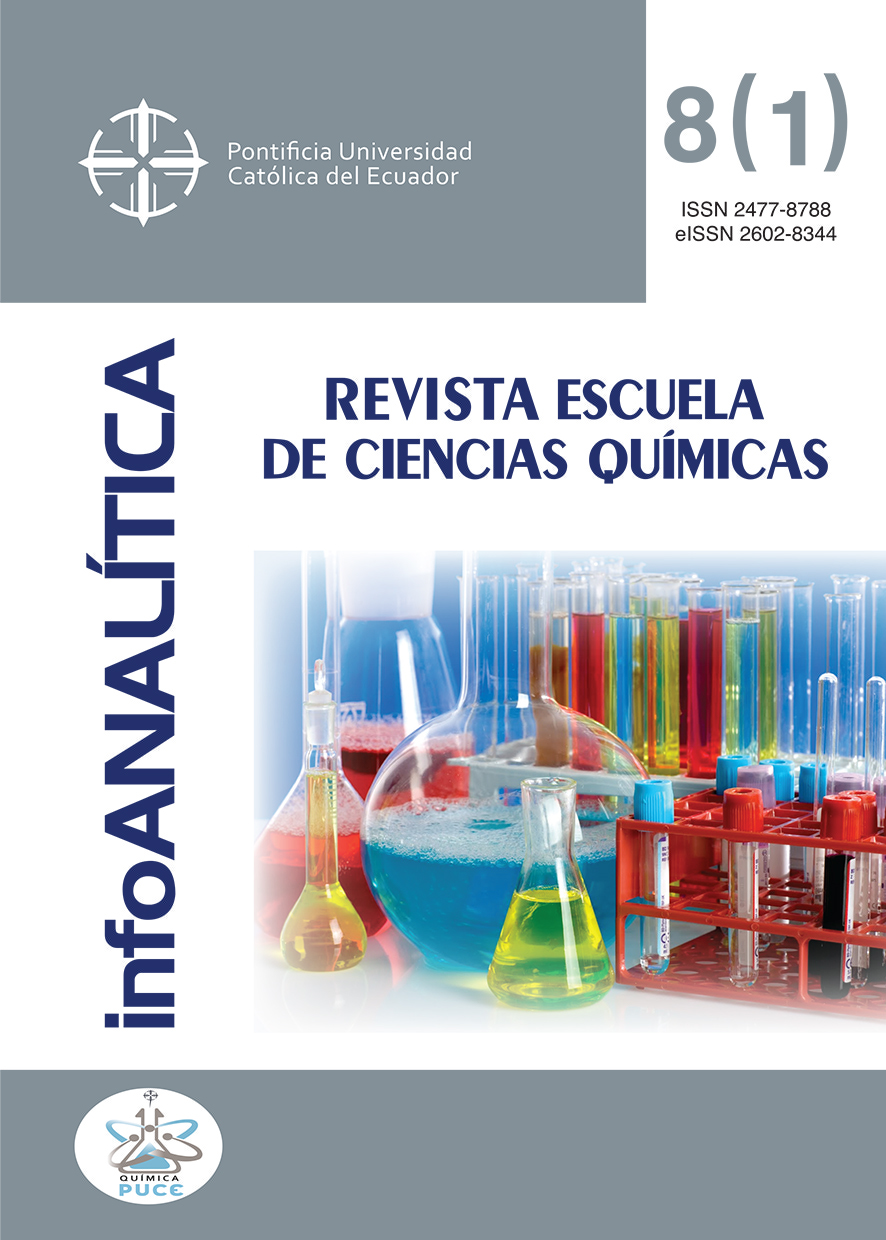ENCAPSULATION EFFICIENCY AND LOAD CAPACITY OF ANTHOCYANINS OF Vaccinium floribundim Kunt IN ZEIN NANOPARTICLE
Main Article Content
Abstract
Zein is a non-polar protein that has a high content of proline and leucine, it can be easily obtained from corn grains and by its composition can form a protein matrix of nanoparticles to encapsulate polar dyes. From decolorized USP zein, nanoparticles were synthesized by the liquid-liquid dispersion method. The synthesis was carried out in 20% ethanol and pH 4, conditions that allow the highest stability of the system. A homogeneous suspension with a particle size of 282,1 nm and a polydispersity of 0.127 corresponding to a surface area of 18.82 m2 / g was obtained; it was evidenced that the particles have a spherical shape and do not present porosity. The nanoparticles thus obtained were used to encapsulate anthocyanins extracted from the mortiño fruit (Vaccinium floribundum Kunth) using the methods of adsorption and incorporation. It was determined that the adsorption method allows to load 338.24 mg of cyanidin-3-glucoside, equivalent to 172.92 g of anthocyanins, per 100 g of nanoparticles, compared with the incorporation method that allowed to encapsulate 72.74 mg of cyanidin-3-glucoside, equivalent to 37.19 g of anthocyanins, per 100 g of nanoparticles. The values of the encapsulation efficiency and load capacity allow to establish that the zein has a high potential encapsulant
Downloads
Article Details
- The authors agree to respect the academic information of other authors, and to assign the copyrights to the journal infoANALÍTICA, so that the article can be edited, published and distributed.
- The content of the scientific articles and the publications that appear in the journal is the exclusive responsibility of their authors. The distribution of the articles published in the infoANALÍTICA Journal is done under a Creative Commons Reconocimiento-CompartirIgual 4.0 Internacional License.
References
Bosquez-Molina, E., Guerrero-Legarreta, I., & Vernon-Carter,J.E. (2003). Moisture barrier properties and morphology of mesquite gum–candelilla wax based edible emulsion coatings. Food Research International, 36 (9); 885-893.
Chang, R. (2007). Química General, 9a edición, Ed. McGraw-Hill.
Díaz, D., Jiménez, M., & Lugo, E. (2016). Propiedades Fisicoquímicas y Estabilidad de la Oleorresina de Paprika Micro y Nano Encapsulada. Universidad Veracruzana.
Ersus, S., & Yurdagel, U. (2007). Microencapsulation of anthocyanin pigments of black carrot (Daucuscarota L.) by spray dryer, Journal of Food Engineering, 80(30), 805–812.
Ezjilarasi, P., Karthik, P., Chhanwal, N., & Anandharamakrishnan, C. (2012). Nanoencapsulation Techniques for Food Componenets: A Review. Food Bioprocess Technol.
Hiemenz, P. C., & Rajagopalan, R. (2017). Principles of Colloid and Surface Chemistry, Third Edition, Revised and Expanded. CRC Press.
Hosseini, S. F., Zandi, M., Rezaei, M., & Farahmandghavi, F. (2013a). Two-step method for encapsulation of oregano essential oil in chitosan nanoparticles: Preparation, characterization and in vitro release study. Carbohydrate Polymers, 95(1), 50–56.
Jones, O., Decker, E. A., & McClements, D. J. (2010). Thermal analysis of lactoglobulin complexes with pectins or carrageenan for production of stable biopolymer particles. Food Hydrocolloids, 24(2-3), 239–248.
Lawton, J. W. (2002). Zein: A history of processing and use. Cereal Chemistry, 79(1), 1–18.
Luo, Y., Teng, Z., & Wang, Q. (2012). Development of zein nanoparticles coated with carboxymethyl chitosan for encapsulation and controlled release of vitamin D3. Journal of Agricultural and Food Chemistry, 60(3), 836–843.
Mohanraj, V. J., & Chen, Y. (2006). Nanoparticles – A Review, Tropical Journal of Pharmaceutical Research, 5(1), 561–573.
Patel, A. Bouwens, E., & Velikov, K., (2010). Sodium caseinate stabilized zein colloidal particles. Journal of agricultural and food chemistry, 58(23), 12497 – 12503.
Patel, A. R., & Velikov, K. P. (2011). Colloidal delivery systems in foods: A general comparison with oral drug delivery. LWT - Food Science and Technology, 44(9), 1958–1964.
Shukla, R., & Cheryan, M. (2001). Zein: The industrial protein from corn. Industrial Crops and Products, 13(3), 171–192.
Suárez, M., & Narváez, G. (2016). Copigmentación intermolecular de antocianinas glicosiladas (Primera). Quito: Editorial Académica Española.
Suárez, M., & Mora, S. (2016). Decoloración de zeína. Universidad Central del Ecuador, Laboratorio de Productos Naturales, Quito Ecuador.
Suárez, M., Yazán, E., & Narváez, G. (2018). Influencia de la estabilización por copigmentación intermolecular sobre la capacidad antioxidante de antocianinas del fruto de Vaccinium floribundum Kunt. infoANALITICA. 6(1), 39-53.
Yoval, L., Palacios, L., Soberanis, M. & Guzmán, L., (2000). Potencial zeta como una herramienta para determinar la aglomeración de las partículas en la reducción del volumen del lodo a disponer. Instituto Mexicano de tecnología del Agua.
Zhong, Q., & Jin, M. (2009). Zein nanoparticles produced by liquid-liquid dispersion. Food Hydrocolloids, 23(8), 2380–2387

